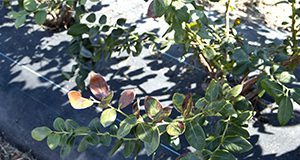Galling or witch's broom damage on the newly expanding buds and leaves of woody ornamental plants has become increasingly common. Diagnosing this damage can be difficult because the most common causes are obscure or occur well before damage symptoms appear. This 6-page fact sheet written by Adam Dale, Erin Harlow, Carrie Harmon, and Chris Marble and published by the UF/IFAS Entomology and Nematology Department is intended to help landscape managers, nursery growers, and pest control professionals diagnose characteristic galling damage, mitigate damage that occurs, and, when possible, prevent it from occurring.
https://edis.ifas.ufl.edu/in1310
Tag: Carrie L. Harmon
Bacterial Wilt of Southern Highbush Blueberry Caused by Ralstonia solanacearum
Bacterial wilt is a newly discovered disease of blueberry in Florida. Plants with bacterial wilt will show signs of water stress such as wilting and marginal leaf burn. The disease was initially confirmed on three farms in Florida. This three-page fact sheet describes the symptoms, occurrence, and management of bacterial wilt in blueberry. Written by Philip F. Harmon, Carrie Harmon, and Dave Norman and published by the Plant Pathology Department.
http://edis.ifas.ufl.edu/pp332
“Candidatus Liberibacter solanacearum”: An Emerging Pathogen Infecting Potato and Tomato

A bacterium called “Candidatus Liberibacter solanacearum” infects potatoes and tomatoes, causing zebra chip in potatoes and psyllid yellows in tomatoes. These disease are highly destructive and have been known to reduce yields by up to 85%. “Ca. L. solanacearum” has been reported in several states, though it has not been detected in Florida, which is the second largest producer of tomatoes and seventh largest producer of potatoes in the US. This 9-page fact sheet covers the biology, distribution, symptoms, transmission, diagnosis, and management of the pathogen and its associated diseases. Written by Binoy Babu, Mathews L. Paret, Nicholas Dufault, and Carrie L. Harmon, and published by the UF Department of Plant Pathology, August 2015.
http://edis.ifas.ufl.edu/pp320
Rose Rosette Disease: A New Disease of Roses in Florida
Rose rosette disease is an incurable, destructive disease that affects both wild and cultivated roses. Over the past several decades, the disease has spread over much of the U.S., though it was first observed in Florida in 2013. This 6-page fact sheet describes the symptoms and diagnosis of the disease, as well as the cultural, chemical, and, possibly, biological controls that can minimize its spread. Written by Binoy Babu, Mathews L. Paret, Tim Schubert, Carlye Baker, Gary Knox, Fanny Iriarte, James Aldrich, Laura Ritchie, Carrie L. Harmon, and Svetlana Y. Folimonova, and published by the UF Department of Plant Pathology, May 2015.
http://edis.ifas.ufl.edu/pp317
RFSR007/SR007 Sample Submission Guide for Plant Diagnostic Clinics of the Florida Plant Diagnostic Network.
Revised! RF-SR007, an 8-page guide by A.J. Palmateer, C.M. Stiles, P.D. Roberts, R.E. Cullen, H. Dankers, R.J. McGovern, N. Peres, P.F. Harmon, and C.L. Harmon, provides extension clientele with the information they need to submit plant samples to Florida Extension Plant Diagnostic Clinics. Published by the UF Department of Plant Pathology, May 2008.
http://edis.ifas.ufl.edu/SR007


